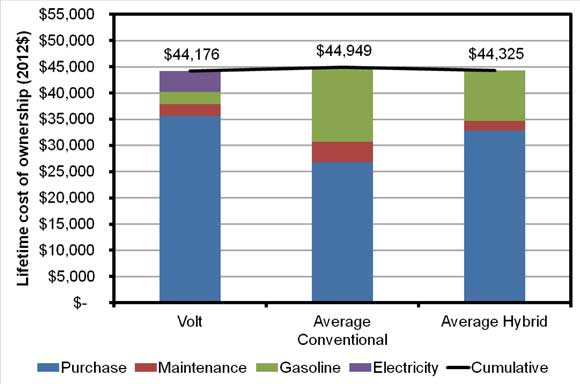Average Lifetime Costs of EV’s Are Within 10% Of Gas Run Vehicles
- 03/06/2015
- Transport
- Posted by Tessa Romarez
- Leave your thoughts
The hefty price tag (electric car cost) when first purchasing an electric vehicle are one of the reasons such cars lose their glossiness and attractiveness within the market.
Such reasons have been proved otherwise by a releases study (by Electric Power Research Institute (EPRI) which has compared the prices of the Nissan Leaf (NASDAQ: NSANY) as well as the Chevy Volt (2013 model) against comparable gas run vehicles in the market at that time.
The results are great for those wishing to live greener, as the two plug-ins were within 10% of gas run vehicles, both gas and hybrids. Because the gasoline prices are not stable, it’s one of the factors that could alter and effect this balance, though state and federal incentives as well as capital costs of the cars are even more imperative to take into account. Driving and maintenance also played a role in the findings.
In order to take into account the various driving patterns of people, EPRI took two different driving scenarios from their data set which was utilised in the report. One case had 83% of driving days that were less than 40 miles while the other case had only 53% driving days which were less than 40 miles.
The differences between these two driving patterns where more conspicuous for drivers purchasing the all-electric Nissan Leaf instead of the plug-in hybrid Chevy Volt.
As can be seen from the graph above, the Chevy Volt has the highest initial cost when compared to the other cars, though EPRI does expect the initial capital cost to be reduced over time as the economies of scale come into play for EV’s as well as newer batter technology being developed. Even though the Volt makes up for such a high purchase price in gas savings, the difference is miniscule.
The Nissan Leaf on the other hand has a great savings component compared to both the gas run and the hybrid run vehicles. The following assumptions made by EPRI include that only at home Level-2 type chargers were utilised and also on the days where the driver needed more distance to be covered, they utilised a traditional vehicle instead.
Under those two assumptions, the Leaf has come out on top, being close to $75,000 cheaper than the other vehicles. It also beat the Volt in terms of monthly spend during a 2 month loan period compared to hybrid or gas run cars.
The study also took into account incentives by California’s for both the Leaf and the Volt, which revealed that the combo of state incentives ($1,500 for the Volt and $2,500 for the Leaf) as well as the high gas price and discounts at charging stations allowed both cars to cost less to operate over a lifetime. The Leaf did come out on top again with $10,000 less than the other cars with incentives from the state.
Incentives do look like they will be discontinued, so will this mean that capital costs will not be reduced?
The cost of running a Level-2 charger has been cut in half by various manufacturer, and take into account that Nissan reduced almost $6,000 from the purchase price of the leaf during 2013, the trend looks set at costs coming down in the future, this is obviously also subject to gas prices which may rise allowing for better prospects concerning EV’s.
There are other factors that could make up for the price differential if costs do not come down fast enough, such as the fact that Texas and California are already constructing fast-charging highways for EV drivers, at the same time the EPA’s newest fuel economy sticker could aid in potential vehicle buyers making better estimates regarding overall lifetime costs of the vehicle itself.

